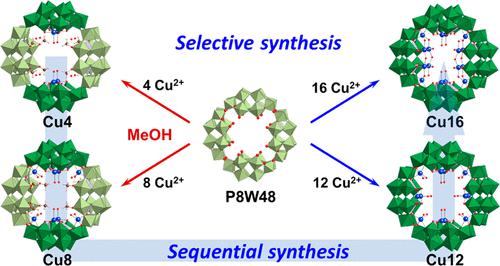当前位置:
X-MOL 学术
›
Inorg. Chem.
›
论文详情
Our official English website, www.x-mol.net, welcomes your
feedback! (Note: you will need to create a separate account there.)
Ligand-Protecting Strategy for the Controlled Construction of Multinuclear Copper Cores within a Ring-Shaped Polyoxometalate
Inorganic Chemistry ( IF 4.3 ) Pub Date : 2022-06-23 , DOI: 10.1021/acs.inorgchem.2c01029 Yoshihiro Koizumi 1 , Kentaro Yonesato 1 , Kazuya Yamaguchi 1 , Kosuke Suzuki 1, 2
Inorganic Chemistry ( IF 4.3 ) Pub Date : 2022-06-23 , DOI: 10.1021/acs.inorgchem.2c01029 Yoshihiro Koizumi 1 , Kentaro Yonesato 1 , Kazuya Yamaguchi 1 , Kosuke Suzuki 1, 2
Affiliation

|
The ring-shaped polyoxometalate (POM) [P8W48O184]40– contains a large cavity and is an attractive inorganic multidentate ligand for accumulating metal cations. Until now, several multinuclear metal cores are constructed within the {P8W48} framework in aqueous solvents. However, it is still challenging to control the number and arrangement of introduced metal cations because of the numerous coordination sites inside the {P8W48} framework. In this study, we developed a novel approach for the selective synthesis of several multinuclear copper-containing ring-shaped POMs in organic solvents using methoxy groups as organic protecting ligands for the reactive coordination sites. Reacting a tetra-n-butylammonium (TBA) salt of [P8W48O184]40– (P8W48) with 4 and 8 equiv of copper(II) acetate in the presence of methanol (MeOH), tetra- and octacopper cores were incorporated into the cavity to form TBA11H13[Cu4(H2O)4P8W48O176(OCH3)8]·28H2O·3CH3NO2 (Cu4) and TBA14H2[Cu8(H2O)12P8W48O176(OCH3)8]·24H2O·CH3CN (Cu8), respectively. For both structures, methoxy groups served as protecting ligands and temporarily inactivated vacant coordination sites. Without MeOH, dodeca- and hexadecacopper cores were constructed inside the cavity to form TBA14H2[Cu12(H2O)16P8W48O184]·4H2O (Cu12) and TBA16H8[Cu16(OH)16(H2O)4P8W48O184]·12H2O·C3H6O (Cu16), respectively. The arrangement of copper ions on the same {P2W12} units could be controlled by the input number of copper ions. Moreover, all four POMs could be synthesized from P8W48 by the stepwise addition of 4 equiv of copper(II) acetate, clarifying the introduction process.
中文翻译:

环状多金属氧酸盐内多核铜芯受控构建的配体保护策略
环状多金属氧酸盐 (POM) [P 8 W 48 O 184 ] 40–含有一个大空腔,是一种有吸引力的无机多齿配体,用于积累金属阳离子。到目前为止,在水性溶剂中的 {P 8 W 48 } 框架内构建了几个多核金属核。然而,由于{P 8 W 48内部有许多配位点,控制引入金属阳离子的数量和排列仍然具有挑战性。} 框架。在这项研究中,我们开发了一种在有机溶剂中选择性合成几种多核含铜环状 POM 的新方法,该方法使用甲氧基作为反应性配位点的有机保护配体。[P 8 W 48 O 184 ] 40- ( P8W48 )的四正丁基铵 (TBA) 盐与 4 和 8 equiv 的乙酸铜 (II) 在甲醇 (MeOH)、四铜和八铜核的存在下反应并入空腔形成 TBA 11 H 13 [Cu 4 (H 2 O) 4 P 8 W 48 O176 (OCH 3 ) 8 ]·28H 2 O·3CH 3 NO 2 ( Cu4 )和TBA 14 H 2 [Cu 8 (H 2 O) 12 P 8 W 48 O 176 (OCH 3 ) 8 ]·24H 2 O· CH 3 CN ( Cu8 )。对于这两种结构,甲氧基用作保护配体和暂时失活的空位配位点。在没有 MeOH 的情况下,在空腔内构建十二铜和十六铜芯以形成 TBA 14H 2 [Cu 12 (H 2 O) 16 P 8 W 48 O 184 ]·4H 2 O ( Cu12 )和TBA 16 H 8 [Cu 16 (OH) 16 (H 2 O) 4 P 8 W 48 O 184 ] ·12H 2 O·C 3 H 6 O( Cu16 )。铜离子在同一{P 2 W 12上的排列} 单位可以通过输入的铜离子数量来控制。此外,所有四种 POM 都可以通过逐步添加 4 equiv 的乙酸铜 (II)从P8W48合成,从而阐明了引入过程。
更新日期:2022-06-23
中文翻译:

环状多金属氧酸盐内多核铜芯受控构建的配体保护策略
环状多金属氧酸盐 (POM) [P 8 W 48 O 184 ] 40–含有一个大空腔,是一种有吸引力的无机多齿配体,用于积累金属阳离子。到目前为止,在水性溶剂中的 {P 8 W 48 } 框架内构建了几个多核金属核。然而,由于{P 8 W 48内部有许多配位点,控制引入金属阳离子的数量和排列仍然具有挑战性。} 框架。在这项研究中,我们开发了一种在有机溶剂中选择性合成几种多核含铜环状 POM 的新方法,该方法使用甲氧基作为反应性配位点的有机保护配体。[P 8 W 48 O 184 ] 40- ( P8W48 )的四正丁基铵 (TBA) 盐与 4 和 8 equiv 的乙酸铜 (II) 在甲醇 (MeOH)、四铜和八铜核的存在下反应并入空腔形成 TBA 11 H 13 [Cu 4 (H 2 O) 4 P 8 W 48 O176 (OCH 3 ) 8 ]·28H 2 O·3CH 3 NO 2 ( Cu4 )和TBA 14 H 2 [Cu 8 (H 2 O) 12 P 8 W 48 O 176 (OCH 3 ) 8 ]·24H 2 O· CH 3 CN ( Cu8 )。对于这两种结构,甲氧基用作保护配体和暂时失活的空位配位点。在没有 MeOH 的情况下,在空腔内构建十二铜和十六铜芯以形成 TBA 14H 2 [Cu 12 (H 2 O) 16 P 8 W 48 O 184 ]·4H 2 O ( Cu12 )和TBA 16 H 8 [Cu 16 (OH) 16 (H 2 O) 4 P 8 W 48 O 184 ] ·12H 2 O·C 3 H 6 O( Cu16 )。铜离子在同一{P 2 W 12上的排列} 单位可以通过输入的铜离子数量来控制。此外,所有四种 POM 都可以通过逐步添加 4 equiv 的乙酸铜 (II)从P8W48合成,从而阐明了引入过程。










































 京公网安备 11010802027423号
京公网安备 11010802027423号